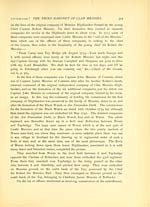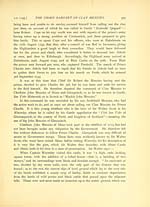Red and white book of Menzies
(474) Page 374
Download files
Complete book:
Individual page:
Thumbnail gallery: Grid view | List view

374 THE "RED & WHITE" BOOK OF MENZIES. [a.d. 1740-1745.
(or before it) is " John Menzies of Comrie," eldest son of Captain James Menzies
of Comrie, as an ensign. The regiment remained in camp at Taybridge for
about eighteen months, during which time all their drills were performed on
the park where they were embodied, on the north side of the river ; and a
splendid field it is for such training.
The dress of the Black Watch was scarlet jacket and waistcoat with buff
facings and white lace, tartan plaid of twelve yards, pleated round the middle
of the body, one end being fixed to the left shoulder, ready to throw loose
and wrap over both shoulders and firelock in rainy weather. At night the
plaid served the purpose of a blanket. These were called " belted plaids,"
from being kept tight to the body by a belt, and worn as full dress. On the
belt hung pistols and dirk. In barracks the little kilt of "philebeg" was worn.
A blue Athole bonnet with a border of red, white, and green, in squares repre-
senting fess check in the arms of Stewart, and a tuft of feathers. The hose
were of Menzies tartan, " Red and White " check, worn in compliment of the
Menzies originators. Their arms were a musket, bayonet, claymore, or basket-
hilted broadsword, furnished by the Government. The gentlemen were allowed
to supply themselves with pistols, dirk, skein-dubh, and target, to complete
the arms of a Highland gentleman, at their own expense. The sword-belt
was of black leather, and the cartouche-box was carrried in front, supported by
a narrow belt round the middle.
The Black Watch are represented as wearing hose of the Menzies full-dress
tartan, "Red and White," on their formation in 1739, also in 1742, then in
1770. They are pourtrayed at the battle of Alexandria with the Menzies check
hose in 1801, from which time to, and at the battle of Waterloo 1815, they
wore the dress Menzies tartan hose; also in 1830 to 1845, and at the Crimea,
throughout which war the Menzies tartan still continued to be the tartan of
their hose, up to about 1854-5. After which the red and black check was
adopted, having worn the " Red and White" Menzies tartan for over 115 years.
Prince Charles Edward raised the standard of his royal house, 19th August
1745, at Loch Shiel in Inverness-shire, and in a short time found himself surrounded
by a large body of enthusiastic Highlanders. On news of the unfurling of the
royal Scottish banner by Prince Charles becoming known, the Government
at once dispatched General John Cope. It is singular that Prince Charles
and Cope placed themselves at the head of their respective armies on the
same day. On 19th of August 1745 General Cope got his commission to
command and to march to Inverness, which was at once commenced, going
by Crieff, on the 21st August, Amulree on the 22nd. His army arrived and
encamped on the parks of Castle Menzies near Taybridge, 23rd and 24th August
1745. General Cope paid a short visit to Chief Sir Robert the Menzies, who
(or before it) is " John Menzies of Comrie," eldest son of Captain James Menzies
of Comrie, as an ensign. The regiment remained in camp at Taybridge for
about eighteen months, during which time all their drills were performed on
the park where they were embodied, on the north side of the river ; and a
splendid field it is for such training.
The dress of the Black Watch was scarlet jacket and waistcoat with buff
facings and white lace, tartan plaid of twelve yards, pleated round the middle
of the body, one end being fixed to the left shoulder, ready to throw loose
and wrap over both shoulders and firelock in rainy weather. At night the
plaid served the purpose of a blanket. These were called " belted plaids,"
from being kept tight to the body by a belt, and worn as full dress. On the
belt hung pistols and dirk. In barracks the little kilt of "philebeg" was worn.
A blue Athole bonnet with a border of red, white, and green, in squares repre-
senting fess check in the arms of Stewart, and a tuft of feathers. The hose
were of Menzies tartan, " Red and White " check, worn in compliment of the
Menzies originators. Their arms were a musket, bayonet, claymore, or basket-
hilted broadsword, furnished by the Government. The gentlemen were allowed
to supply themselves with pistols, dirk, skein-dubh, and target, to complete
the arms of a Highland gentleman, at their own expense. The sword-belt
was of black leather, and the cartouche-box was carrried in front, supported by
a narrow belt round the middle.
The Black Watch are represented as wearing hose of the Menzies full-dress
tartan, "Red and White," on their formation in 1739, also in 1742, then in
1770. They are pourtrayed at the battle of Alexandria with the Menzies check
hose in 1801, from which time to, and at the battle of Waterloo 1815, they
wore the dress Menzies tartan hose; also in 1830 to 1845, and at the Crimea,
throughout which war the Menzies tartan still continued to be the tartan of
their hose, up to about 1854-5. After which the red and black check was
adopted, having worn the " Red and White" Menzies tartan for over 115 years.
Prince Charles Edward raised the standard of his royal house, 19th August
1745, at Loch Shiel in Inverness-shire, and in a short time found himself surrounded
by a large body of enthusiastic Highlanders. On news of the unfurling of the
royal Scottish banner by Prince Charles becoming known, the Government
at once dispatched General John Cope. It is singular that Prince Charles
and Cope placed themselves at the head of their respective armies on the
same day. On 19th of August 1745 General Cope got his commission to
command and to march to Inverness, which was at once commenced, going
by Crieff, on the 21st August, Amulree on the 22nd. His army arrived and
encamped on the parks of Castle Menzies near Taybridge, 23rd and 24th August
1745. General Cope paid a short visit to Chief Sir Robert the Menzies, who
Set display mode to:
![]() Universal Viewer |
Universal Viewer | ![]() Mirador |
Large image | Transcription
Mirador |
Large image | Transcription
Images and transcriptions on this page, including medium image downloads, may be used under the Creative Commons Attribution 4.0 International Licence unless otherwise stated. ![]()
| Histories of Scottish families > Red and white book of Menzies > (474) Page 374 |
|---|
| Permanent URL | https://digital.nls.uk/96658420 |
|---|
| Description | A selection of almost 400 printed items relating to the history of Scottish families, mostly dating from the 19th and early 20th centuries. Includes memoirs, genealogies and clan histories, with a few produced by emigrant families. The earliest family history goes back to AD 916. |
|---|

